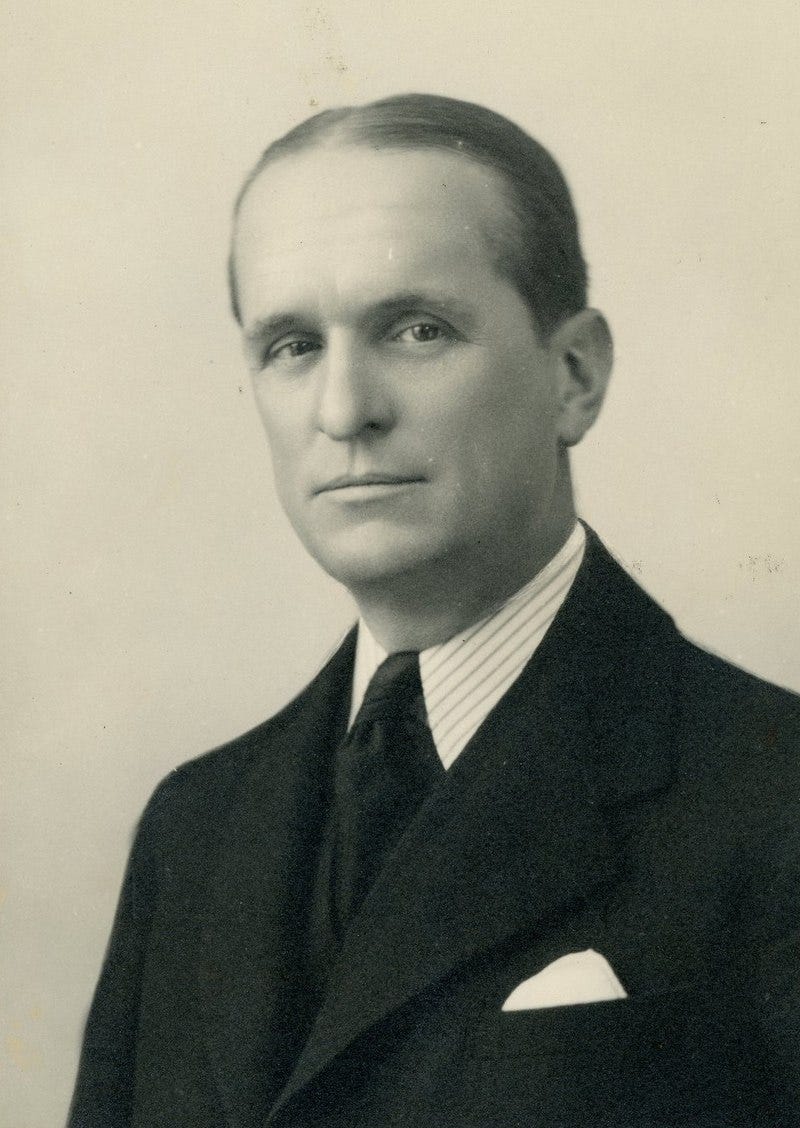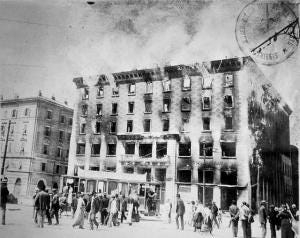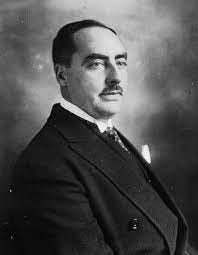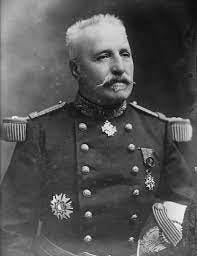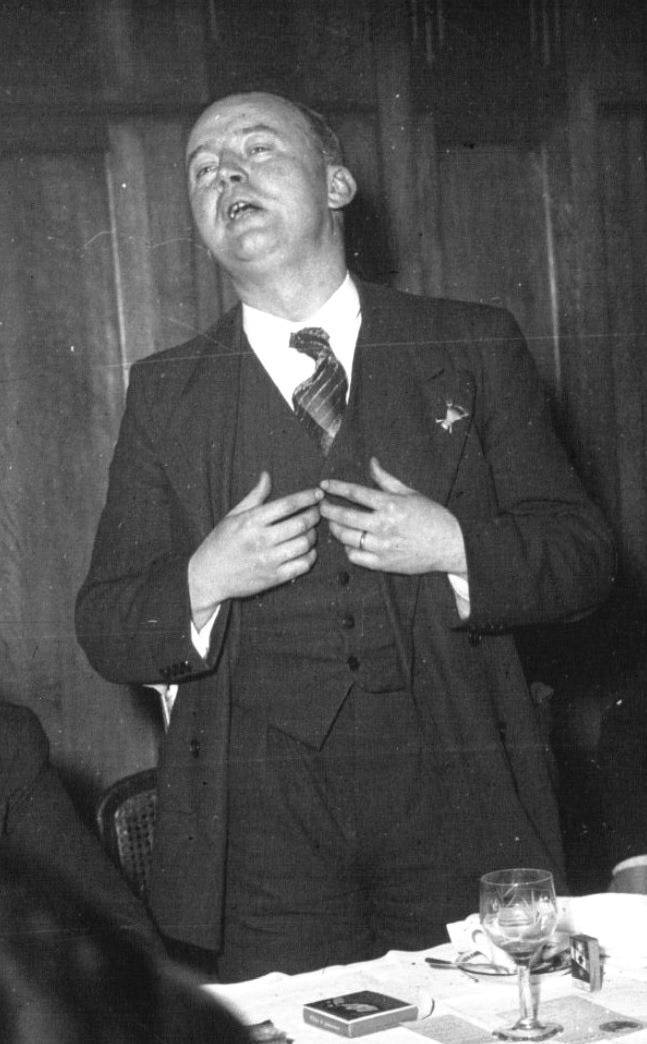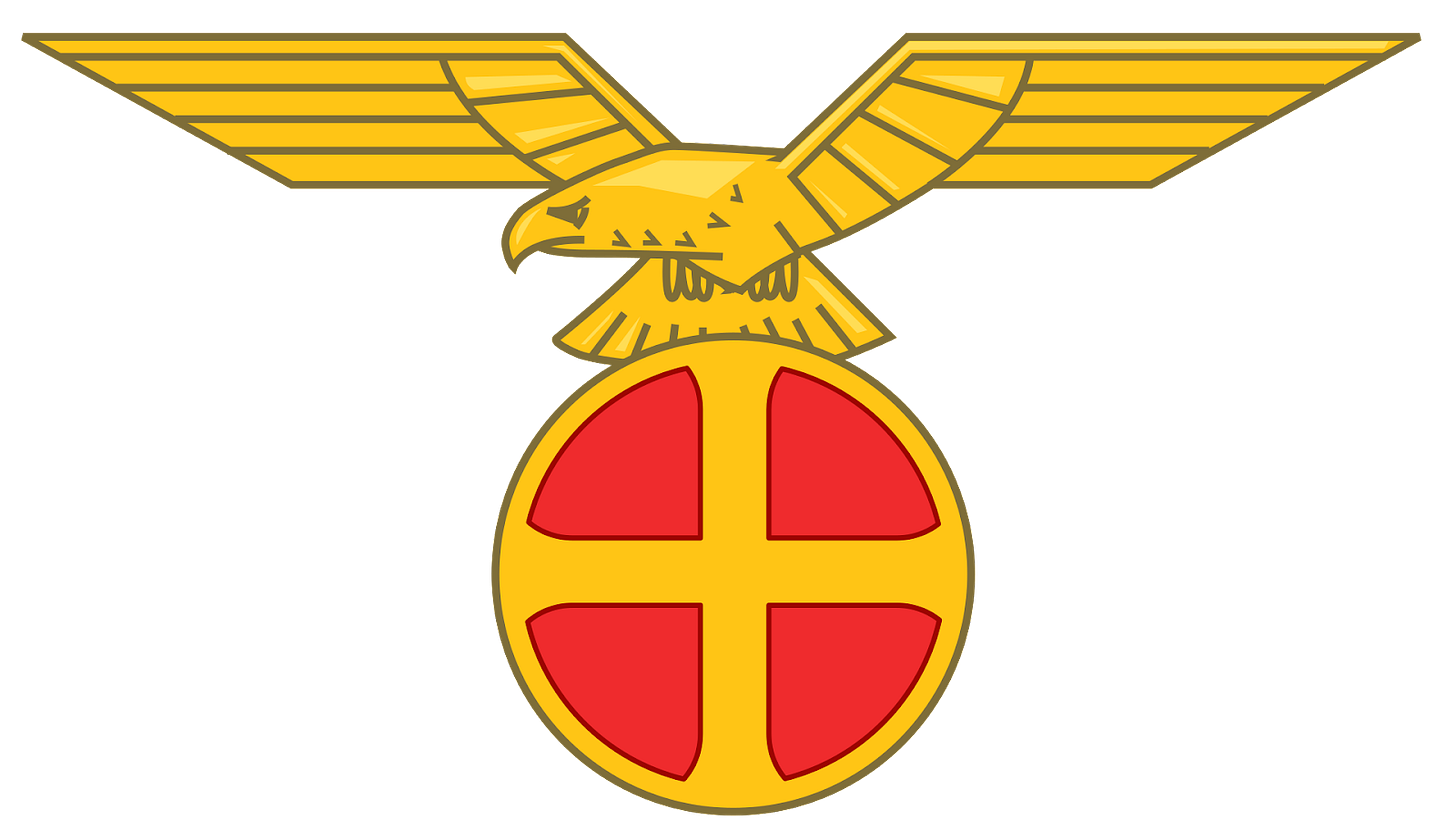Introduction
Paxton’s Anatomy of Fascism can be read here. Read my notes on chapter two here.
This chapter is especially interesting as it shows the elements that allow for fascism to succeed or fail. A perhaps surprising elements is the opportunities created for fascism because of actions that otherwise seem objectively good, such as the Left becoming more intolerant for anti-Semitism among their ranks. It also demonstrates the clear way that fascism collaborates with liberals and conservatives to gain power. Especially interesting though are the cases where this doesn’t happen, as in France.
As the world today seems to face similar crises, such as the constant political deadlock and incompetence of the Democrats in the United States, the fear of left-wing uprisings like the George Floyd protests, and the normalization of violence and open disregard for the law of the Republican party after the January 6th attack on the Capitol, there is a frightening similar recipe for fascism. The comparison to the 6 February Crisis in France is perhaps comforting, but that was also followed swiftly by intense legal consequences for the fascists. While the January 6 rioters have faced many consequences, it does not feel to have killed any movements when Trump is able to simply run again and criminal indictments are used as campaign tools.
Chapter 3: Taking Root
Successful Fascisms
While basically every country on earth had a fascist movement, many of them didn’t amount to anything, such as the Greyshirts of Iceland or the New Guard of New South Wales, Australia.
Only a few fascist movements became more than street orators and bullies. These “successful” fascisms competed with other political parties, and convinced influential people they could fulfill their ambitions.
Their success influenced the entire political system, making things more aggressive, legitimizing extreme nationalism, Left-baiting, and racism.
The political system also influenced the fascists, forcing them to be more precise with their language. They could not make the same wide-range of complaints to voice the resentment of everyone (except socialists) who felt unrepresented. They had to offer their followers concrete advantages, and decide their priorities.
This was the first test between fascist rhetoric and action, although the rhetoric did not disappear, of course. In practice, fascism’s anti-capitalist rhetoric proved to be highly selective, only really being used against the property rights of foreigners or minorities.
It turned out in practice that fascists’ anticapitalism was highly selective. Even at their most radical, the socialism that the fascists wanted was a “national socialism”: one that denied only foreign or enemy property rights (including that of internal enemies). They cherished national producers. Above all, it was by offering an effective remedy against socialist revolution that fascism turned out in practice to find a space. If Mussolini retained some lingering hopes in 1919 of founding an alternative socialism rather than an antisocialism, he was soon disabused of those notions by observing what worked and what didn’t work in Italian politics. His dismal electoral results with a Left-nationalist program in Milan in November 1919 surely hammered that lesson home.
Successful fascists movements pragmatically appealed to domestic capitalists.
Unsuccessful fascists tried to remain “pure,” appealing to idealism and disdaining elections. For example: Jose Antonio Primo de Rivera of Falange Espanola…
...Charles Maurras of Action Française…
…François de la Rocque of Croix de Feu…
…or Ferenc Szálasi of the Arrow Cross.
By contrast, Hitler and Mussolini felt destined to rule. They participated in bourgeois elections and made themselves indispensable. This electoral success meant losing some followers, but gaining others. When Mussolini first turned his movement into a party, some saw this as betraying their anti-parliamentarian routes. They were no longer the “antiparty” described by Jose Antonio or Emilio Gentile, which was “neither of the Right nor of the Left.” Hitler’s NSDAP claimed to be a party from the beginning, but members still thought it unlike other parties. Fascists called themselves “the movement,” camp, band, gatherings (rassemblements), or fasci. They were brotherhoods to unite and energize the nation.
But the name for fascists was a trivial issue. The more significant problems were the compromises they had to make to gain power, teaming up with the capitalists and bourgeois politicians despite the fact that rejecting “the establishment” was part of the initial appeal of fascism.
How the fascists managed to retain some of their antibourgeois rhetoric and a measure of “revolutionary” aura while forming practical political alliances with parts of the establishment constitutes one of the mysteries of their success.
Success required more than prioritization and alliances. It also required a new style, finding a politics for people who hated politics and wanted an “antipolitics.” Fascists promised unity where other parties sewed division. Fascists were “parties of engagement,” where the tone was set by intensely active and committed militants rather than careerist politicians. But only some societies had the right conditions to let fascism succeed.
For comparison of what circumstances lead to fascism’s success or failure, this chapter will look at two examples of successful fascism (Italy and Germany), and one example where it failed (France).
The Po Valley, Italy, 1920-22
Mussolini suffered an embarrassing electoral defeat in November 1919. He was saved by a new tactic: squadrismo.
His militant veteran supporters formed strong-arm “action squads,” squadre d’azione, to attack perceived internal enemies of the Italian nation. Mussolini had set the precedent himself in the April 1919 attack on the socialist newspaper, Avati.
The squadre started in Trieste, a multi-nationalist cosmopolitan port city. To establish Italian supremacy, a fascist squad burned down the Balkhan hotel in July 1920, which the Slovene Association had used as their headquarters.
Mussolini wasn’t the only one to occupy cities. In 1919, Gabriele D’Annunzio was a bigger celebrity as a veteran and poet. He had his own squad occupy the port of Fiume, which had been awarded to Yugoslavia after WW1.
D’Annunzio introduced a lot of the theatricality Mussolini would adopt like balcony speeches, uniformed parades, the “Roman salute,” etc. (See the Behind the Bastards episode on him!)
D’Annunzian Fiume worked as a kind of martial popular republic, serving as a model of national liberation movements. But without support from the Italian government, it failed, and Italy negotiated its return to Yugoslavia before driving out the D’Annunzians.
Mussolini did not actively support the occupation of Fiume, but utilized it a ton. Once in power, he made Yugoslavia recognize it as an Italian city in 1924, and adopted a lot of D’Annunzio’s mannerism.
Mussolini succeeded where D’Annunzio failed because he was able to build successful political alliances. Fascism is more than mere political theater.
Mussolini also succeeded because he addressed economic interests beyond nationalistic ones. His Blackshirts were available to attack socialists and South Slavs.
Squadrismo was especially useful for this. The socialists started organizing the braccianti (landless laborers) for better wages, large estates began hiring the squadrismo to attack them. The veterans involved hated the anti-war socialists anyway.
Socialism had been a growing threat against the economic interests of these large estates. Italian socialists had achieved electoral victory in the first postwar election (November 1919). They used their power to establish control over the agricultural wage-labor market. Farmers that needed workers needed to visit the socialist Labor Exchange, which would negotiate better conditions, wages, and job security.
Farmers could not turn to the government for help. Local politicians were often socialist, and the laissez-faire liberal PM declined to use national force to break strikes. So instead, they turned to the Blackshirts, who were more than happy to enact violence on socialists.
Glad for an excuse to attack their old pacifist enemies, fascist squadre invaded the city hall in Bologna, where socialist officials had hung up a red banner, on November 21, 1920. Six were killed. From there, the movement quickly spread throughout the rich agricultural country in the lower Po River delta. Black-shirted squadristi mounted nightly expeditions to sack and burn Labor Exchanges and local socialist offices, and beat and intimidate socialist organizers. Black-shirted squadristi mounted nightly expeditions to sack and burn Labor Exchanges and local socialist offices, and beat and intimidate socialist organizers. Their favorite forms of humiliation were administering uncontainable doses of castor oil and shaving off half of a proud Latin moustache. In the first six months of 1921, the squads destroyed 17 newspapers and printing works, 59 Peoples’ Houses (socialist headquarters), 119 Chambers of Labor (socialist employment offices), 107 cooperatives, 83 Peasants’ Leagues, 151 socialist clubs, and 151 cultural organizations. Between January 1 and April 7, 1921, 102 people were killed: 25 fascists, 41 socialists, 20 police, and 16 others.
Fascists succeeded not only by force, but economically. They gave some peasants what they wanted: jobs and land, the latter being given by some far-sighted landlords. Socialists lost their hold on these farmworkers, who saw both that socialists had not been able to defend their postwar gains and who saw collectivization as unattractive.
The squadristi’s success undermined faith in the Italian state. The Blackshirts started occupying entire cities, like Ferrara. Police helped the fascists attack socialists, lending them equipment and even personnel.
This marked a change in the character of fascism. Fascists still advocated some public policies, like public works for the unemployed, but the squadristi essentially made them the strong-arm of the landlords. Some early idealist fascists were horrified by this transformation, like Barbato Gatelli. But Mussolini sided with the squadristi. The lost idealists were replaced with the sons of landlords and young police officers.
This marked a greater shift away from the somewhat Left-wing positions of early fascism further into the Right. The early fascists (radical veterans, pro-war syndicalists, and futurists) were “young anti-bourgeois malcontents” that wanted a grand national change. Besides its nationalism, the fascists were very similar to socialists in the Catholic party, the Partito Popolare Italiano. Mussolini himself had been a socialist. Thanks to squadrismo, fascism was now shifted to the right, recruiting sons of landlords and criminals. What remained was a youthful revolt against the elders.
We can track the shift right in Mussolini’s speeches and programs.
Early fascism had some anti-war points, which was the first thing they eliminated. The San Sepolcro program had accepted the League of Nation’s idea of national integrity. The league was eliminated from the program in 1919, but retained some ideas like replacing the army with a defensive militia, and nationalizing arms and munitions factories. In November 1921, the Fascist Party was firmly anti-League, saying it was biased, demanding more Italian colonies, and supported a standing army.
Early fascism had called for nationalizations and heavy taxes. This was watered down by 1920, where workers would just have a say in personnel decisions with management. By 1921, fascists rejected “confiscatory taxation” as “discouraging initiative,” and made productivity the highest goal of the economy.
Early fascism was anti-clerical. Mussolini was a lifelong atheist, and the fascism of 1919 had called for seizing church property. By June 1921, Mussolini was praising the Catholic tradition of Italy.
Early fascism was anti-monarchy. By 1920, Mussolini’s republicanism softened to agnosticism. By September 1922, Mussolini denied any intent to call the monarchy into question.
Despite dropping its anti-capitalism, anti-clerical, and anti-monarchy tendencies, fascism still presented as a “Fascist revolution.”
Long after his regime had settled into routine, Mussolini still liked to refer to the “Fascist revolution.” But he meant a revolution against socialism and flabby liberalism, a new way of uniting and motivating Italians, and a new kind of governmental authority capable of subordinating private liberties to the needs of the national community and of organizing mass assent while leaving property intact. The major point is that the Fascist movement was reshaped in the process of growing into the available space. The antisocialism already present in the initial movement became central, and many antibourgeois idealists left or were pushed out. The radical anticapitalist idealism of early Fascism was watered down, and we must not let its conspicuous presence in early texts confuse us about what Fascism later became in action.
The de facto power of fascists in rural northeast Italy became too great for politicians to ignore. When PM Giolitti was trying to build a coalition against socialists in May 1921 to roll back the socialist wave of 1919, he brought the Fascists in an coalition with liberals and nationalists. Mussolini was elected into the Italian chamber.
This all shows why it’s so hard to find an “essence” of fascism. Had the Fascists not abandoned their antibourgeois rebellion to become the strongarm of the landlords of the Po Valley (and similar landlord alliances in Tuscany and Apulia), Mussolini would have remained some obscure failed agitator.
Schleswig-Holstein, Germany, 1928-33
Schleswig-Holstein became the only territory to give the Nazis a majority vote in a free election, winning 51 percent on July 31, 1932. To understand what made fascism successful here, it is important to focus on this territory in particular.
German fascism failed to establish itself immediately after WW1. They had to abandon their urban strategy to start appealing to rural farmers. Agriculture had suffered as new markets opened up around the world, which worsened in the 1929 crash. Usually Schleswig-Holstein voted for the conservative nationalist party, DNVP. But they lost faith in traditional parties.
The Weimar Republic was triply damned in their eyes: dominated by distant Prussia, by sinful and decadent Berlin, and by “reds” who thought only of cheap food for urban workers.
Schleswig-Holstein first turned to the Landbund, a violent peasant self-help league organizing tax strikes and protests, but this failed without national support. So in July 1932, 64% of rural farmers voted in the Nazis. They likely would have switched again, had Hitler not been appointed chancelor in January 1933.
The failure of traditional elites and organizations in the face of the 1929 depression opened up space for the Nazis. The Nazis used exciting speeches and grand gestures, with uniformed squads, dramatic arrivals by plane, and fast, open Mercedeses. By contrast, the traditional parties gave bookish speeches to an educated elite. The socialists had salutes and shirts, but could not recruit outside the working class. The Nazis promised something to everyone, and made tailor-made appeals to different occupations. That these speeches contradicted each other didn’t matter.
This cost the Nazis money, which they needed to get from somewhere. It is often alleged that German businessman paid the bills. In fact, the orthodox Marxist answer is that Hitler was created by this business class as a private anticommunist army. But while it is true that many small businesses supported the Nazis, they supported other groups as well. The success of the Nazis can only be partially explained this way.
It is indeed possible to discover German businessmen (usually from small business) who were attracted by Hitler’s expansionist nationalism and antisocialism and deceived by his carefully tailored addresses to business audiences which downplayed antiSemitism and suppressed any reference to the radical clauses in the 25 Points. The steel manufacturer Fritz Thyssen, whose ghostwritten book I Paid Hitler (1941) provided ammunition for the Marxist case, turns out to be exceptional, both in his early support for Nazism and in his break with Hitler and exile after 1939. Another famous businessman, the aged coal magnate Emil Kirdorf, joined the Nazi Party in 1927 but left it angrily in 1928 over Nazi attacks on the coal syndicate, and he supported the conservative DNVP in 1933.
Close scrutiny of business archives shows that most German businessmen hedged their bets, contributing to all the nonsocialist electoral formations that showed any signs of success at keeping the Marxists out of power. Though some German firms contributed some money to the Nazis, they always contributed more to traditional conservatives. Their favorite was Franz von Papen.
Businessmen were primarily motivated by their anti-socialism, leading them to hedge their bets among other parties, their preferred ones being conservatives. The radical language and violence of the Nazis was concerning and insufficiently tailored to their interests. The Nazis had even cooperated with the communist in a strike to abolish trusts in late 1932.
Besides this, an important part of Nazi funding then came from entry fees, selling Nazi pamphlets and memorabilia, and small contributions. It is not only the support of big businesses, but these small donations that allowed them to operate. The Nazis were a catch-all party.
His [Hitler's] Storm Troopers aroused both fear and admiration by their readiness to beat up socialists, communists, pacifists, and foreigners. Direct action and electioneering were complementary, not contradictory, tactics. Violence—selective violence against “antinational” enemies who were perceived by many Germans as outside the fold—helped win the votes that allowed Hitler to pretend that he was working for power by legal means.
The liberals had failed to deal with twin crises of the late 1920s: the national humiliation of the Treaty of Versailles in repaying war debt, and the Depression of 1929. In July 1932, the Nazi Party was the largest in Germany, with 37% of the vote. They did not have a majority, and never would, but they were indispensable for an antisocialist coalition.
But the Nazis were losing momentum and money. Hitler took a gamble, refusing all offers of vice chancellorship, to become chancellor. Strasser was ejected from the party for negotiating with the new Chancellor, General Schleicher.
The Nazis might have remained a historical footnote, had their movement not been saved in 1933 by the conservatives that wanted to use their muscle.
An Unsuccessful Fascism: France, 1924-40
French Fascists
Fascism was not unique to Italy and Germany, but it did not come close to taking power anywhere else. A comprehensive analysis of fascism must study these movements well to tell us more about its overall nature and precisely why it failed where it did.
France is a good example. While France is often characterized by the French Revolution, it retained many right-wing monarchists and nationalists that hated this new republic. This republic was also threatened with its own triple crisis: revolutionary threat, economic depression, and German menace.
The socialists of Cartel des Gauches (Coalition of the Left) won in 1924. This pushed the growth of the extreme right in opposition. Georges Valois, who had previously founded the Cercle Proudhon (Circle Proudhon) in 1911, now founded Le Faisceau (Fascist) based on Mussolini.
Pierre Taittinger founded the more traditionally nationalist Jeunesses Patriotes (Young Patriots).
General Noël Currières de Castelnau made the Fédération Nationale Catholique passionately anti-republican.
In the 1930s, the Depression hurt France just as the Nazis became a bigger threat. The center-left majority of the Third Republic (renewed in 1932) took the blame and was tarnished as corrupt. This allowed new radical Right “leagues” (they rejected the word “party”) to grow. This growing right-wing threat led to the 6 February 1934 crisis, where these leagues rioted near the French National Assembly in an attempted coup, resulting in the death of 16 people. (Note: Paxton justified calling Trump a fascist, in contrast to a mere right-wing populist authoritarian, based on the close parallels between the January 6 attack on the US Capitol and the French February 6 crisis.)
The fascists “proved that they were strong enough to topple a French government but not strong enough to install another one in its place.”
Things polarized after this, and the left picked up votes. The Popular Front of socialists won the May 1936 elections, and paramilitary leagues were banned in June by the Jewish socialist PM Leon Blum. The Right got even more paranoid about having a Jew in office supported by communists.
It is debated how fascist France really was. Some say it just picked up superficial similarities, while others say it was the cradle of fascism itself. The question is how significant were the detractors of democracy in France, and whether they were fascist.
The fascists movements that copied Hitler and Mussolini the most closely did worst of all, like Solidarité Française or Jacques Doriot’s Parti Populaire Français.
Rleatively more moderate and republican right-wing did better, like Colonel François de La Rocque’s Parti Social Français.
The fascism of France depends on whether we count La Rocque as a fascist. If he was, then fascism was powerful in France. If he wasn’t, then it wasn’t.
Was La Rocque fascist?
La Rocque, a career army officer from a monarchist family, took over in 1931 the Croix de Feu, a small veterans’ association of those decorated with the Croix de Guerre for heroism under fire, and developed it into a political movement. He drew in a wider membership and denounced the weakness and corruption of parliament, warned against the threat of Bolshevism, and advocated an authoritarian state and greater justice for workers integrated into a corporatist economy. His paramilitary force, called dispos (from the French word disponible, or “ready”), embarked on militaristic automobile rallies in 1933 and 1934. They mobilized with precision to pick up secret orders at remote destinations for “le jour J” (D day) and “l’heure H” (H hour) in apparent training to combat by force a communist insurrection.
The Left denounced La Rocque as a fascist, especially after the march on the Chamber of Deputies. Yet La Rocque men were relatively discipline compared to the typical fascist open street violence. He also rejected anti-Semitism, even recruiting patriotic Jews (even if there was some anti-Semitism in his ranks).
When the Popular Front government dissolved paramilitary organizations, including the Croix de Feu, La Rocque replaced it with the electoral party Parti Social Français (PSF), pushing to unite the country under a strong authoritarian leader. The move to the center grew their membership. They were certainly big, but it’s hard to say how big. The 1940 election where they were expected to do well was cut short by the war.
France was more stable in 38-39. The far right fascists lost power, except for La Rocque’s more moderate PSF. When France was defeated by the Nazis, it was not these more radical fascist groups that took power, but the collaborationist PSF that worked in the Vichy government.
The Failure of Fascism in France
Fascism did not fail in France by magic.
The French had a strong republican tradition.
The Depression was less severe in France than other industrialized nations.
The Third Republic never suffered complete deadlock.
Conservatives did not call on fascists for help.
No French fascist reached the prominence by dealmaking that Hitler or Mussolini did.
Example of the Greenshirts
A special case of French fascism should be considered in the agrarian Greenshirts. They had been openly fascist early on, and attracted embittered farmers. Fascism in Germany and Italy found similar success among this group. France was largely agrarian still, and the government was embarrassed in the face of collapsing farm prices.
The Greenshirt leader, Henry Dorgères, openly praised fascism and adopted fascist habits and prejudices. There was even a crisis for direct action with a farmer’s strike in 1936 and 37. But the Greenshirts never had the success of German and Italian fascists.
The French government cracked down on them aggressively. Even the Left Leon Blum sent the gendarmes to suppress strikes orchestrated by them. French farmers did not feel they needed to reach out to fascists for help, instead adopted to build a conservative coalition within the state apparatus.
Fascists have a hard time getting into functional systems. People accept newcomers when the system is failing.
Dorgères also failed to make a plan for appealing to the urban middle class. Rural France also had a strong love of the French Revolution, as peasants got their own plot of land. The French Communists had a much better time of recruitment. Rural France was therefore not a good atmosphere for fascist recruitment.
Some Other Unsuccessful Fascisms
There were a few other examples of where fascists got traction.
In Hungary, the Arrow Cross Party won 750,000 out of 2,000,000 votes in May 1939. But the government was already controlled by conservatives, who had no intention of sharing power.
In Romania, the Legion of the Archangel Michael, later the Iron Guard, was the third largest party, winning 66 out of 390 seats in the legislature.
The most successful electoral fascists in western Europe was Léon Degrelle’s Rexist movement in Belgium. It was an extreme Catholic monarchist party, denouncing the main Catholic Party as corrupt. The Rexists had a minor electoral victory with 11.5% of the popular vote. But they quickly lost these gains as the conservatives and catholics disavowed him, instead uniting with the socialists for the candidate Paul Van Zeeland. He took Degrelle’s seat next year.
Rapid swelling for fascist movements can rapidly fall too.
Other fascist movements had less electoral success.
The Dutch Nationaal Socialistische Beweging won 7.94%, then declined.
In Norway, Vidkun Quisling’s Nasjonal Samling won 2.2% in 1933, and 1.8% in 1936.
An especially interesting case of failed fascism is Oswald Mosley’s British Union of Fascists. Mosley was very intelligent and one of the best socially connected fascist chiefs. He worked in the Labour government until he was kicked out for unorthodox and isolationist economic proposals, and then started a failed “New Party.” He was converted to fascism after meeting Mussolini. Mosley’s British Union of Fascists won important early converts, like the publisher of the Daily Mail.
But public opinion turned against Mosley after his fascists beat up opponents at a public meeting in London in June 1934. Hitler’s Night of Long Knives came at the end of the same month, further turning public opinion against fascism. 90% of the BUF members left, including the Daily Mail publisher.
Mosley turned to anti-Semitism, and went through East Londong to beat up Jews and communists.
After the Battle of Cable Street on October 4, 1936, the Public Order Act deprived Mosley of his public spectacles. He grew his movement with his anti-war campaign in 1939. But Mosley’s personal connection with Hitler made him alien to the British public, and the recovering economy after 1931 restored faith in the conservative government.
Other fascist movements never really got off the ground, like in Ireland with Eoin O’Duffy’s Blueshirts. They could do little more than get a colored shirt, march around, and beat up minorities. They came nowhere close to the success of Hitler or Mussolini.
Successful fascism needs a crisis to exploit, a political opening, a set of alliance building, and cooperation from existing elites. Where fascism did not have this, it failed.
Comparison and Conclusions
The success or failure of the many fascist movements was not just differences within the movements, but the opportunity available. To understand late-stage fascism, we must understand its helpers.
Intellectual history helps less here. Some places were intellectually primed for fascism, like in France. Yet it failed, as we saw. And there were similar intellectuals in all countries.
Anti-Semitism is most obvious here. Yet it seems like a poor predictor for the success of fascism. It was not the most anti-Semitic countries that fell to fascism.
If one had been asked around 1900 to identify the European nation where the menace of anti-Semitism seemed most acute, who would have chosen Germany? It was in France after 1898, during the Dreyfus frenzy, that Jewish shops were looted, and in French Algeria that Jews were murdered. Ugly anti-Semitic incidents occurred in Britain at the turn of the century, and in the United States, such as the notorious lynching of Leo Frank in Atlanta, not to mention those traditionally rabid centers of endemic anti-Jewish violence in Poland and Russia, where the very word pogrom was invented.
In Germany, by contrast, organized anti-Semitism, vigorous in the 1880s, lost steam as a political tactic in the decades before World War I. After the war, Jewish advancement into posts like university teaching became easier in Weimar Germany than in the United States of Harding and Coolidge. Even Wilhelmian Germany may have been more open to Jewish professional advancement than the United States of Theodore Roosevelt, with important exceptions such as the officer corps. What comparison reveals about Wilhelmian Germany is not that it had more numerous or more powerful anti-Semites and rebels against “modernity” than other European states, but that in a political crisis the German army and bureaucracy were less subject to effective judicial or political oversight.
Intellectual preparation is still important for fascism though, serving three functions:
Discrediting previous liberal regimes
Creating non-left poles for anger and protest, which had been a monopoly of the Left
Making fascist violence respectable
We also need to study the old elite that was ready to cooperate with or tried to coopt fascism. While similarly anti-liberal, different economic situations were in place.
Crises of Liberalism
Failure to Engage in Mass Politics
There needed to be a faltering liberal order. Existing governments need to function badly, or not at all. There is a crisis of liberalism.
Government was meant to have little intervention within liberalism, except to defend property from workers and foreign competition. This kind of liberal state ended with World War 1, which required massive government coordination and regulation.
The governments could not return to the old liberal order. Some failed entirely, with Russian being taken over by the Bolsheviks, and the fascists taking power in Italy and Germany. In Europe, authoritarian governments took over parliamentary systems in Spain, Portugal, Poland, Romania, Yugoslavia, Estonia, Lithuania, and Greece.
This was a failure of the old method of rule with the nationalized masses. A rule by well-educated, well-bred “notables” had no idea how to appeal to a crowd. They relied on the old methods, now outdated, and shunned the new methods of propaganda. Fascists took advantage of the conservative failing.
Whereas the notable dinosaurs disdained mass politics, fascists showed how to use it for nationalism and against the Left. They promised access to the crowd through exciting political spectacle and clever publicity techniques; ways to discipline that crowd through paramilitary organization and charismatic leadership; and the replacement of chancy elections by yes-no plebiscites. Whereas citizens in a parliamentary democracy voted to choose a few fellow citizens to serve as their representatives, fascists expressed their citizenship directly by participating in ceremonies of mass assent. The propagandistic manipulation of public opinion replaced debate about complicated issues among a small group of legislators who (according to liberal ideals) were supposed to be better informed than the mass of the citizenry. Fascism could well seem to offer to the opponents of the Left efficacious new techniques for controlling, managing, and channeling the “nationalization of the masses,” at a moment when the Left threatened to enlist a majority of the population around two nonnational poles: class and international pacifism.
Economic Transition to Industrialization
Countries that transitioned to industrialization later had a harder time with fascism.
Britain did relatively well, whereas countries like Italy did not. These latecomers also had to deal with better organized labor. Even non-Marxists can see how this is a problem.
Marxists, until recently, saw this crisis as an unavoidable stage of capitalism, requiring imposing discipline on workers and expansion. We can take the weaker claim that this just caused more social turmoil in the transition.
Social Transition to Industrialization
Pre-industrial classes could not move over to industrialization. Artisans, landowners, and rentiers were stuck between the old world and the new. A previously powerful middle class that lost social prestige is recruiting ground for fascism.
Transition to Modern Culture
Cultural norms changed with the move to universal literacy, cheap mass media, and immigration. This made it harder for liberals to maintain the same intellectual and cultural order.
Synthesis
Ultimately, we don’t need to choose just one of these factors. It might be a combination of all four, and they all seem to apply to Italy and Germany. Italy was late to industrialize, while Germany had a very strong worker’s movement.
Maps of Fascism
While fascism does require a political crisis to exploit, the existence of such a crisis does not guarantee the success of fascism. The element of choice still plays an important role.
Fascism and WWI
The proximate cause for fascism in the 20th century was World War I. Fascism had greater success in countries that lost. With Germany, this was done through the “stabbed in the back” myth. Italy is an exception, since it was on the winning side, but it failed to see the national expansion it expected. It had a vittoria mutilata (mutilated victory).
Spain had been neutral in WWI, but had recently lost the Spanish-American war of 1898. The Spanish radical right grew in fear of republicanism in Catalonia and Basque. But Spain saw the rise of Franco’s military dictatorship, not José Antonio’s Primo de Rivera’s fascism.
Fascism and Bolshevism
Countries that saw attempts at or fears of Bolshevik revolutions turned to fascism. Germany, Italy, and Hungary all feared communist takeovers. But this map isn’t perfect either. Belgium feared ethnic divisions, not class divisions.
Communism succeeded where there was a weak middle class and a large landless peasantry. Where the middle class was strong, fascism succeeded.
In settings where a large landless peasantry added massive numbers to a revolutionary movement, and where large portions of the middle class were still struggling for the most elementary rights (rather than defending established privileges), as in Russia in 1917, mass protest gathered on the Left. Communism, not fascism, was the winner. Revolutionary Russia did contain anti-Bolshevik squads that resembled the German Freikorps,78 but a society where landless peasants far outnumbered an insecure middle class offered no mass following to fascism. Russia came close to a military dictatorship in July 1917 when General Lavr Georgyevich Kornilov tried to march on Moscow, and that would have been a likely outcome if Bolshevism had failed in Russia.
Fascism and Weak Liberalism
The existence of a crisis is not enough. The liberal state also had to be weak and unable to respond to it. Trotsky’s “least barricaded gate” analogy works as well for fascism as it did for communism.
The frequent assertion that fascism stems from a crisis of liberalism might well be amended to specify crises in weak or failed liberalisms.
We shouldn’t try and look for fascist “national character” or “hereditary predilections,” as if German society were inherently fascist. This is close to “reverse racism.”
It is true that places with a weak tradition of human rights and democracy was more open to fascism. Democracy was a sign of pride for Britain and France. For Germany, it was a reminder of their defeat.
The Failure of Other Ideologies
None of the three main 19th century ideologies took hold of the crisis, so people looked for new options.
Conservatives
Conservatives would have preferred traditional answers post-1918. They wanted to pacify the excitable crowds, and return power to a gentlemanly elite. But mass politics could not be abolished, especially after the emotional propaganda of WWI.
Liberals
Liberals wanted to return to the omnipotent market. Unregulated markets were abandoned for the war effort though, and the opposition to regulation was seen as a tool of the Left.
In the Po Valley, it was the failure of the liberal state to defend landlords that had them turn to fascist militias. And it was liberal Europe that had plunged the world into war, rather than bringing about the peace it promised.
The Left
The Left was also becoming solidified, rather than a catch-all for the discontent. In the 19th century, the Left could include antisemites, nationalists, artisans, and middle class democrats. It could no longer do this in 1919.
As its organizations became disciplined and domesticated by Marxism after the 1880s, it tried to expel the old working-class xenophobia it had once tolerated. Especially in 1920, reacting against the patriotic brainwashing of the war and awaiting world revolution expectantly, the Left had no room for the Nation within the international revolutionary cause.
Noncommunist socialists were seen as having missed the revolutionary boat of 1917. The world revolution did not come.
Fascism now was an alternative for the youth that wanted to change the world.
Formation of Fascism
Fascism first needed a chief to work as a “gatherer.” This gatherer needed to know how to build a coalition and work a crowd. D’Annunzio could not build a coalition for a coup, while Mussolini did. No competing “chief” could work a crowd like Hitler.
The chief also needed to know how to avoid purity to take power. The Italian Fascist Party started as left nationalist, but, seeing this space was occupied, it went to the right to defend the landlords of the Po Valley. The Nazi Party broadened its appeal after 1928 to court farmers desperate from going broke.
Fascism and Polarization
Polarization helped the fascists and the communists. The Nazis presented themselves as the most effective anticommunist force, and the liberals as failing to effectively deal with it. The communists presented the social democrats as unequipped to deal with a revolutionary situation.
Fascist violence was not random. It was targeted specifically at the “national enemies.” For fascism, the law was not a neutral arbitrator, but a weapon to be used to brutalize the demonized internal enemy.
Fascist violence was neither random nor indiscriminate. It carried a well-calculated set of coded messages: that communist violence was rising, that the democratic state was responding to it ineptly, and that only the fascists were tough enough to save the nation from antinational terrorists. An essential step in the fascist march to acceptance and power was to persuade law-and-order conservatives and members of the middle class to tolerate fascist violence as a harsh necessity in the face of Left provocation. It helped, of course, that many ordinary citizens never feared fascist violence against themselves, because they were reassured that it was reserved for national enemies and “terrorists” who deserved it.
Fascists encouraged a distinction between members of the nation who merited protection and outsiders who deserved rough handling. One of the most sensational cases of Nazi violence before power was the murder of a communist laborer of Polish descent in the town of Potempa, in Silesia, by five SA men in August 1932. It became sensational when the killers’ death sentences were commuted, under Nazi pressure, to life imprisonment. Party theorist Alfred Rosenberg took the occasion to underscore the difference between “bourgeois justice,” according to which “one Polish Communist has the same weighting as five Germans, frontsoldiers,” and National Socialist ideology, according to which “one soul does not equal another soul, one person not another.” Indeed, Rosenberg went on, for National Socialism, “there is no ‘law as such.’” The legitimation of violence against a demonized internal enemy brings us close to the heart of fascism.
Fascists enjoyed the beauty of violence. It gave an outlet to young men that felt cheated out of war. And the ruling class did not care about violence targeted at their enemy.
It was the genius of fascism to wager that many an orderly bourgeois (or even bourgeoise) would take some vicarious satisfaction in a carefully selective violence, directed only against “terrorists” and “enemies of the people.”
Polarization risked sending people left. But Hitler and Mussolini that they could build a bigger tent than the blue-collared workers that turned to communism.
Parallel Structures
Fascists and serious Marxist revolutionaries set up parallel structures to the state, replicating government agencies. The Nazi Party had its own foreign policy agency. Once in power, it shared this space with the traditional Foreign Office. The party police were especially important here. The fascist militia challenged the state’s monopoly on violence.
These structures let fascists claim they could run things better than the state, and replace state functions once in power.
Leninist parties followed a similar method. However, once in power, the party totally eclipsed the traditional state, whereas with fascism they kept both in permanent tension. This will be seen in Chapter 5.
Accomplices of Fascism
The success of fascism also depended on the support of its allies and accomplices.
For Mussolini, his squadristi were supported by the police and army.
Wherever public authorities winked at direct action against communists or socialists without troubling themselves too much about the niceties, a door was opened to fascism. At this point, judicial and administrative due process was fascism’s worst enemy.
In Italy, the centrist dealmaker Giovanni Giolitti helped Mussolini’s legitimacy, bringing him into the centrist-nationalist coalition.
Now he was essential for any anti-socialist coalition.
Bringing new parties into the system is usually a profoundly wise political step, but not when it rewards violence and an unrepentant determination to abolish democracy.
Fascism is Not Inevitable
With all these preconditions, we might think that wherever we see them, we will automatically get fascism.
This is not true, because it ignores human choice, especially of the existing leaders to welcome fascism.
Having assembled a catalogue of preconditions, intellectual roots, and longer-term structural preconditions, we might be tempted to believe we can foresee exactly where fascism is likely to appear, grow, and take power. But that would mean falling into a determinist trap. There remains the element of human choice. It was by no means guaranteed that a nation fitted with all the preconditions would become fascist. Only the “vulgar” Marxist interpretation holds that capitalism will eventually get into trouble and inevitably need to adopt a fascist formula to save itself, and even sophisticated Marxists have ceased to believe in such inevitability.
As we will see in the next chapter, it took the decisions of powerful individuals to open the gates to fascism. That was the final essential precondition of successful fascism: decision-makers ready to share power with fascist challengers.










